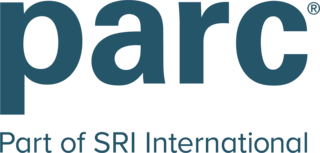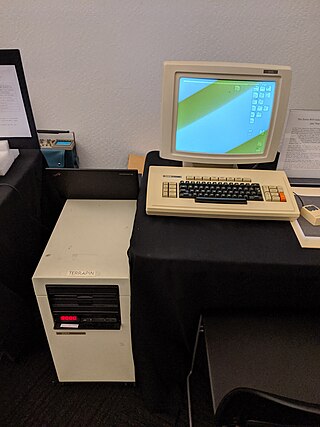
A graphical user interface, or GUI, is a form of user interface that allows users to interact with electronic devices through graphical icons and visual indicators such as secondary notation. In many applications, GUIs are used instead of text-based UIs, which are based on typed command labels or text navigation. GUIs were introduced in reaction to the perceived steep learning curve of command-line interfaces (CLIs), which require commands to be typed on a computer keyboard.

The history of the graphical user interface, understood as the use of graphic icons and a pointing device to control a computer, covers a five-decade span of incremental refinements, built on some constant core principles. Several vendors have created their own windowing systems based on independent code, but with basic elements in common that define the WIMP "window, icon, menu and pointing device" paradigm.

Memex is a hypothetical electromechanical device for interacting with microform documents and described in Vannevar Bush's 1945 article "As We May Think". Bush envisioned the memex as a device in which individuals would compress and store all of their books, records, and communications, "mechanized so that it may be consulted with exceeding speed and flexibility". The individual was supposed to use the memex as an automatic personal filing system, making the memex "an enlarged intimate supplement to his memory". The name memex is a portmanteau of memory and expansion.

A word processor is an electronic device for text, composing, editing, formatting, and printing.

SRI Future Concepts Division is a research and development company in Palo Alto, California. It was founded in 1969 by Jacob E. "Jack" Goldman, chief scientist of Xerox Corporation, as a division of Xerox, tasked with creating computer technology-related products and hardware systems.

Xerox Holdings Corporation is an American corporation that sells print and digital document products and services in more than 160 countries. Xerox is headquartered in Norwalk, Connecticut, though it is incorporated in New York with its largest population of employees based around Rochester, New York, the area in which the company was founded. The company purchased Affiliated Computer Services for $6.4 billion in early 2010. As a large developed company, it is consistently placed in the list of Fortune 500 companies.

The Xerox Alto is a computer system developed at Xerox PARC in the 1970s. It is considered one of the first workstations or personal computers, and its development pioneered many aspects of modern computing. It features a graphical user interface (GUI), a mouse, Ethernet networking, and the ability to run multiple applications simultaneously. It is one of the first computers to use a WYSIWYG text editor and has a bit-mapped display. The Alto did not succeed commercially, but it had a significant influence on the development of future computer systems.

The Xerox Star workstation, officially named Xerox 8010 Information System, is the first commercial personal computer to incorporate technologies that have since become standard in personal computers, including a bitmapped display, a window-based graphical user interface, icons, folders, mouse (two-button), Ethernet networking, file servers, print servers, and email.

Adele Goldberg is an American computer scientist. She was one of the co-developers of the programming language Smalltalk-80, which is a computer software that simplifies the programming language, and has been the basis of knowledge and structure for many other programming languages such as Python, C, and Java. She also developed many concepts related to object-oriented programming while a researcher at the Xerox Palo Alto Research Center (PARC), in the 1970s.

A cubicle is a partially enclosed office workspace that is separated from neighboring workspaces by partitions that are usually 5–6 feet (1.5–1.8 m) tall. Its purpose is to isolate office workers and managers from the sights and noises of an open workspace so that they may concentrate with fewer distractions. Cubicles are composed of modular elements such as walls, work surfaces, overhead bins, drawers, and shelving, which can be configured depending on the user's needs. Installation is generally performed by trained personnel, although some cubicles allow configuration changes to be performed by users without specific training.

In computing, the desktop metaphor is an interface metaphor which is a set of unifying concepts used by graphical user interfaces to help users interact more easily with the computer. The desktop metaphor treats the computer monitor as if it is the top of the user's desk, upon which objects such as documents and folders of documents can be placed. A document can be opened into a window, which represents a paper copy of the document placed on the desktop. Small applications called desk accessories are also available, such as a desk calculator or notepad, etc.

The KiddiComp concept, envisioned by Alan Kay in 1968 while a PhD candidate, and later developed and described as the Dynabook in his 1972 proposal "A personal computer for children of all ages", outlines the requirements for a conceptual portable educational device that would offer similar functionality to that now supplied via a laptop computer or a tablet or slate computer with the exception of the requirement for any Dynabook device offering near eternal battery life. Adults could also use a Dynabook, but the target audience was children.

Coined in 1987, the term Knowledge Navigator described a future computing system and how people might use it to navigate worlds of knowledge. In a sense, the user is actually the “Knowledge Navigator,” though the term often refers to the system’s primary interface, a tablet computer. That part often stands for the whole system. The term is also the title of an Apple “vision video.” The concept was described by former Apple Computer CEO John Sculley and John A. Byrne in their book, Odyssey: Pepsi to Apple.
“A future-generation Macintosh, which we should have early in the twenty-first century, might well be a wonderful fantasy machine called the Knowledge Navigator, a discoverer of worlds, a tool as galvanizing as the printing press. Individuals could use it to drive through libraries, museums, databases, or institutional archives. This tool wouldn't just take you to the doorstep of these great resources as sophisticated computers do now; it would invite you deep inside its secrets, interpreting and explaining—converting vast quantities of information into personalized and understandable knowledge.”

"The Mother of All Demos" was a landmark computer demonstration of developments by the Augmentation Research Center, given at the Association for Computing Machinery / Institute of Electrical and Electronics Engineers (ACM/IEEE)—Computer Society's Fall Joint Computer Conference in San Francisco, by Douglas Engelbart, on December 9, 1968. The name The Mother of All Demos has been retroactively applied to the demonstration.

Charles Patrick "Chuck" Thacker was an American pioneer computer designer. He designed the Xerox Alto, which is the first computer that used a mouse-driven graphical user interface (GUI).
The Xerox NoteTaker is a portable computer developed at Xerox PARC in Palo Alto, California, in 1978. Although it did not enter production, and only around ten prototypes were built, it strongly influenced the design of the later Osborne 1 and Compaq Portable computers.

Pen computing refers to any computer user-interface using a pen or stylus and tablet, over input devices such as a keyboard or a mouse.

"As We May Think" is a 1945 essay by Vannevar Bush which has been described as visionary and influential, anticipating many aspects of information society. It was first published in The Atlantic in July 1945 and republished in an abridged version in September 1945—before and after the atomic bombings of Hiroshima and Nagasaki. Bush expresses his concern for the direction of scientific efforts toward destruction, rather than understanding, and explicates a desire for a sort of collective memory machine with his concept of the memex that would make knowledge more accessible, believing that it would help fix these problems. Through this machine, Bush hoped to transform an information explosion into a knowledge explosion.

Norman Lloyd "Norm" Cox is an American interaction designer best known for inventing the hamburger icon.
A word processor (WP) is a device or computer program that provides for input, editing, formatting, and output of text, often with some additional features.



















